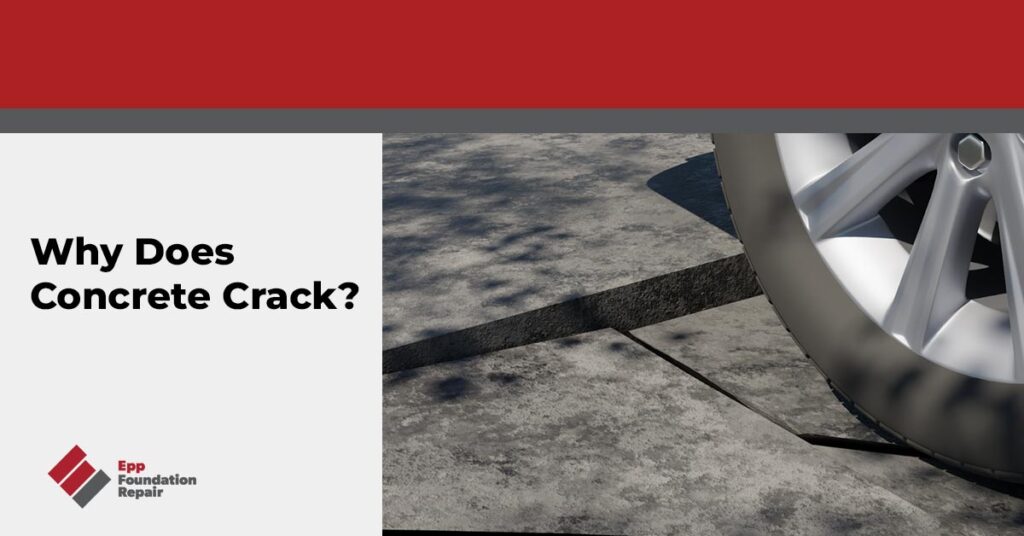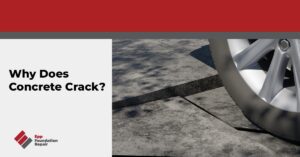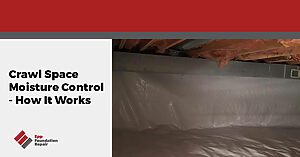Wondering why concrete cracks? If so, you’ve landed on the right page because that’s what we’re going to review in this article. We’ll go over why concrete cracks, repair options for a cracked concrete slab, and how you can help prevent cracked concrete slabs.
Why Cracked Concrete Can Be A Problem
A cracked concrete slab poses several problems, including the following:
Water infiltration
Cracks in concrete slabs allow water to seep into the slab, causing mold growth. Water can also freeze inside the crack and cause it to get bigger.
Rebar corrosion
If the concrete slab contains rebar, water can enter the crack and cause the rebar to rust and expand, causing the surrounding concrete to crack further and lose its bond with the rebar. This can create a feedback loop that can lead to structural failure eventually.
Trip hazard
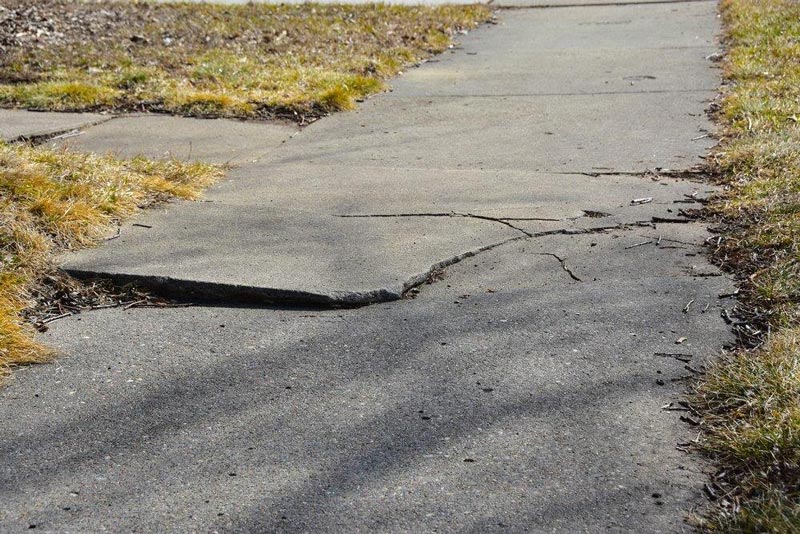
Cracked concrete is often uneven, a trip hazard that could result in serious injury and a lawsuit.
Can indicate underlying issues
A cracked concrete slab can indicate a problem with the soil that could also negatively affect your home’s foundation.
If you have a cracked concrete slab on your property, it’s essential to have it evaluated by an experienced foundation repair contractor and fixed as soon as possible.
Why Does Concrete Crack?
When it comes to construction, concrete is a durable, strong, and versatile material. However, it’s not entirely impervious to damage. Concrete can crack for various reasons, including the following:
Shrinkage
Shrinkage cracks are very common. They happen as the concrete cures (i.e., hardens). You’ll hear them referred to as plastic shrinkage cracks. The term “plastic” refers to the fact that these cracks appear on the surface of the concrete before it hardens.
Shrinkage cracks happen because concrete in its plastic state contains a lot of water, which takes up space. As it cures, it releases moisture and shrinks. Because concrete is a rigid material, the shrinking stresses it, which can lead to cracking. When the concrete mix contains too much water, it’s more likely to develop shrinkage cracks.
Expansion
Expansion cracks in concrete slabs occur when the concrete expands due to temperature changes. When concrete heats up, it expands and pushes against whatever is in its way. This might be a wall or another slab of concrete. If the thing it’s pushing against can’t flex, the expanding concrete slab will crack.
Heaving
Freeze/thaw cycles can also cause concrete slabs to crack. This happens because the ground expands as it freezes and pushes up on the slab. When the ground thaws, the slab settles back down again. This movement can cause a concrete slab to crack.
Invasive tree roots can also cause concrete slabs to crack. As tree roots grow beneath the slab, they can push up on it, leading to cracks. We’ve all seen examples of this.
Settlement
When a concrete slab is poured, it’s designed to rest on stable, compacted soil. However, if the soil hasn’t been adequately prepared, the slab can settle into the ground after it’s poured, causing it to crack.
Decaying organic matter, such as leaves, branches, and roots, can also cause settlement by creating voids in the ground under the slab. If the slab settles into the voids, it could crack.
Excessive weight
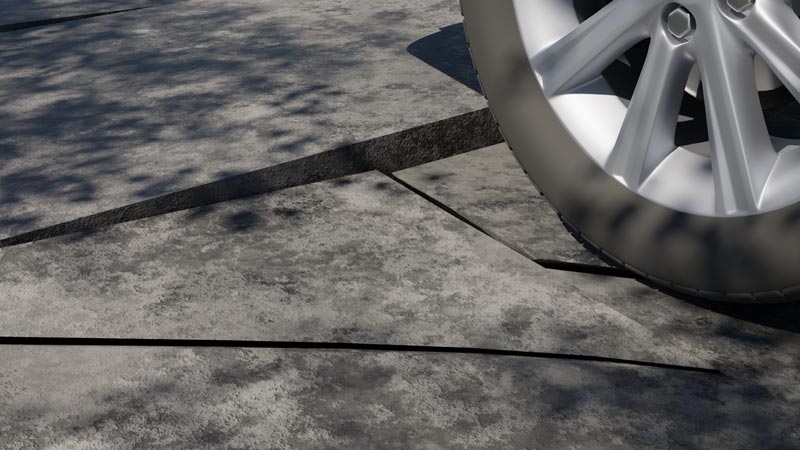
Another cause of cracked concrete is the inability of the slab to bear the weight of something heavy. In concrete slabs on residential property, this usually isn’t caused by the failure of the slab itself to bear the weight but rather by the ground under the slab. For example, poor drainage under the slab can cause the soil to become soggy and unable to support whatever’s on top.
Premature drying
When the top of the concrete slab dries too quickly, crazing cracks can form. These are tiny cracks that look something like a spider’s web. While you might not like how they look, they don’t affect the structural integrity of the slab.
How Are Cracked Concrete Slabs Repaired?
Fortunately, there are various methods available to repair cracked concrete slabs. These include the following:
Polyurethane foam injection
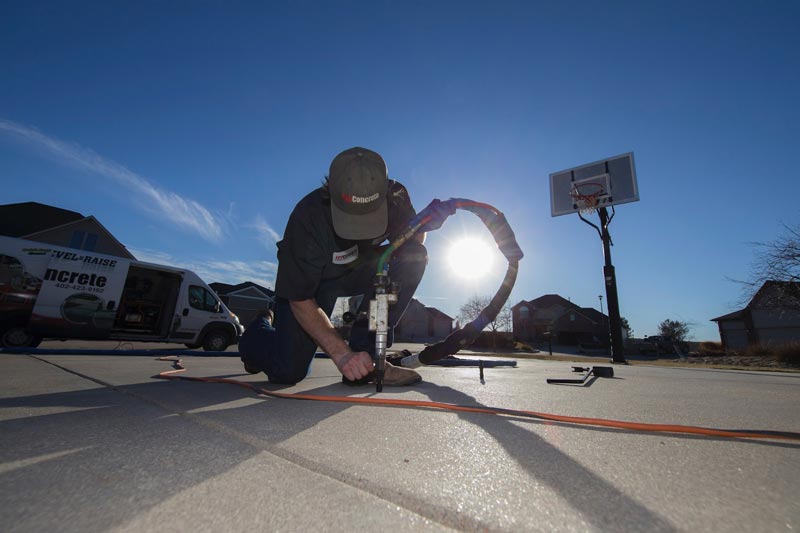
A cracked, uneven concrete slab can often be repaired using a technique known as polyurethane foam injection. This involves drilling small holes in the affected slab and injecting a rapidly expanding foam underneath it to lift and level the slab. The cracks can then be sealed using epoxy crack injection. For more information, see What Is Concrete Leveling?
Epoxy crack injection
Epoxy can repair tiny cracks, typically less than 0.25 inches wide. The epoxy is injected into the crack, creating a strong, watertight bond when it hardens.
Slab replacement
If a concrete slab is severely damaged, it will need to be replaced. This involves removing the damaged slab and replacing it with a new one.
How To Prevent Cracks In Concrete
Cracks in concrete are inevitable, a fact of life. However, there are some things contractors can do to help prevent them. These include using a combination of control joints, expansion joints, and keeping the surface moist while the concrete cures.
Control joints
Control joints – straight lines cut into the slab during installation – provide a predetermined area for the concrete to crack, minimizing the chance of random and uncontrolled cracks. These joints are placed at specific intervals in the slab to a depth of approximately one-quarter of the slab’s thickness.
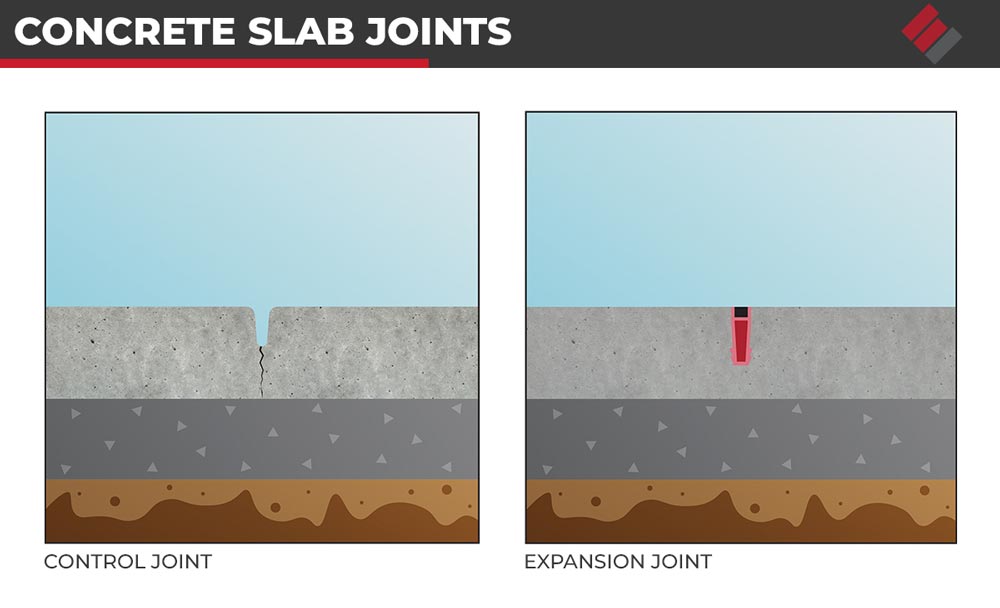
Expansion joints
Expansion joints are created and then filled with a compressible material that acts as a shock absorber. This allows the concrete to expand and contract with temperature changes without cracking. Expansion joints prevent concrete from cracking as it expands against other surfaces such as a pipe, a brick wall, etc.
Don’t let the surface dry too fast
Cracks can be prevented by keeping the surface of the concrete wet during the curing process. Additionally, shielding the slab from direct sunlight can help minimize the evaporation rate.
If you’re concerned about a cracked concrete slab on your property, contact us today to schedule an evaluation and receive a repair estimate. We serve areas in four states: Nebraska, Iowa, Kansas, and Missouri.

